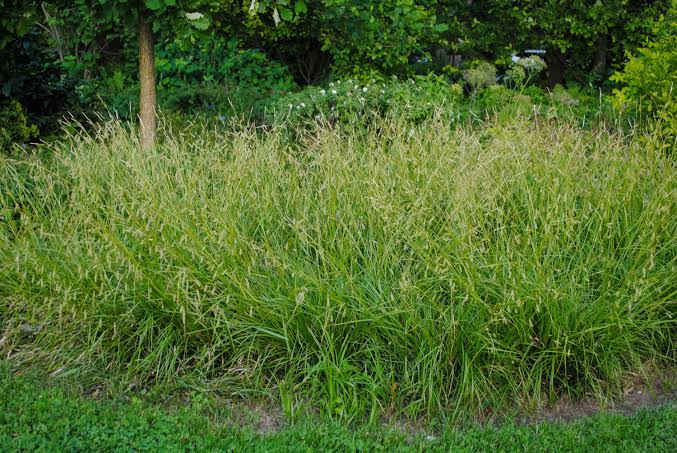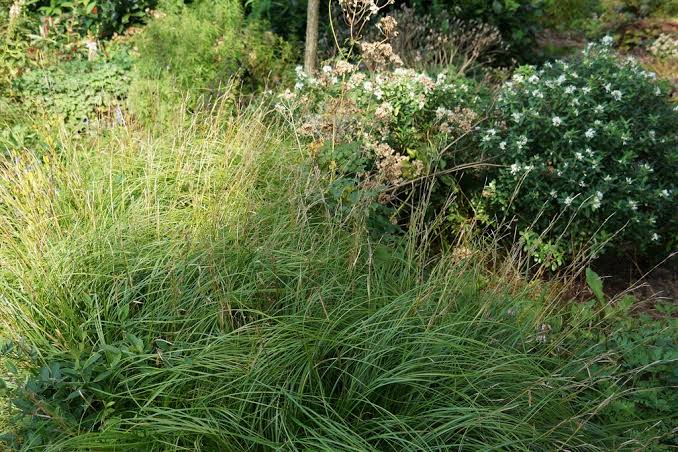Wolftail sedge (Carex cherokeensis) is a fascinating plant that belongs to the sedge family, Cyperaceae. Found predominantly in the southeastern United States, this perennial herbaceous plant thrives in various ecosystems, from wetlands to woodlands.
The distinctive feature of Wolftail sedge lies in its slender, arching leaves that gracefully sway in the breeze. The plant earns its common name from the resemblance of its flower clusters to the bushy tail of a wolf. These unique inflorescences, known as spikes, can be quite eye-catching, enhancing the aesthetic appeal of the natural landscapes they inhabit.
In terms of habitat, Wolftail sedge demonstrates remarkable adaptability. It is often found in moist soils, along stream banks, or in shaded areas within forests. This adaptability contributes to its widespread distribution and ecological importance, providing habitat and sustenance for various wildlife species.
One of the ecological roles of Wolftail sedge is its contribution to soil stabilization. The extensive root system of this plant helps prevent soil erosion, making it an essential component in maintaining the structural integrity of ecosystems. Additionally, the plant’s presence supports biodiversity by providing shelter for small organisms and serving as a food source for certain herbivores.
Observing Wolftail sedge in its natural habitat reveals a delicate interplay between the plant and its surroundings. The slender leaves create a mosaic of greenery, contributing to the overall biodiversity of the ecosystem. As part of the larger ecological web, this sedge plays a vital role in maintaining the balance of its habitat.
Propagation of Wolftail sedge occurs through both seeds and rhizomes. This reproductive strategy ensures the resilience and continuity of the species. The seeds, often dispersed by wind or water, enable the plant to colonize new areas, contributing to its ability to thrive in various environments.
Cultivating an appreciation for Wolftail sedge goes beyond its ecological contributions; it extends to its cultural significance. Native American communities, particularly the Cherokee people, historically utilized various species of Carex, including C. cherokeensis, for traditional purposes such as basket weaving.
Wolftail sedge is not merely a botanical specimen but a dynamic and integral component of the ecosystems it inhabits. Its slender elegance and ecological significance underscore the importance of preserving and appreciating the diverse flora that graces our natural landscapes.
Read Also: The Appearance and Features of Sharks
How To Grow Wolftail Sedge (Carex cherokeensis)

To cultivate Wolftail sedge (Carex cherokeensis), follow these simple guidelines:
1. Select the Right Location: Choose a planting site with moist soil, preferably near streams, in woodland areas, or other locations with consistent moisture. Wolftail sedge thrives in shaded environments.
2. Prepare the Soil: Ensure the soil is well-draining and rich in organic matter. Amending the soil with compost can enhance its fertility and structure.
3. Planting Depth: Place the Wolftail sedge seeds or seedlings at the appropriate depth, typically around 1 to 2 inches below the soil surface.
4. Watering: Maintain consistent moisture, especially during the initial stages of growth. Regular watering is crucial for the establishment of Wolftail sedge.
5. Mulching: Apply a layer of organic mulch around the base of the plant to help retain soil moisture, suppress weeds, and regulate soil temperature.
6. Sunlight: While Wolftail sedge prefers shaded conditions, it can tolerate some sunlight. However, providing partial to full shade is ideal for optimal growth.
7. Fertilization: Wolftail sedge generally does not require heavy fertilization. If needed, use a balanced, slow-release fertilizer in the spring.
8. Pruning: While Wolftail sedge is relatively low-maintenance, removing dead or damaged foliage can enhance its appearance and overall health.
9. Propagation: If you desire additional plants, Wolftail sedge can be propagated by dividing mature clumps or by collecting and planting seeds.
10. Monitoring: Keep an eye on the soil moisture levels and adjust watering accordingly. Regular observation will help you identify and address any issues promptly.
11. Support Wildlife: Appreciate the ecological role of Wolftail sedge by welcoming the wildlife it attracts. The plant contributes to biodiversity, providing habitat and sustenance for various organisms.
By following these straightforward steps, you can successfully grow and enjoy the unique beauty of Wolftail sedge in your garden or natural landscape.
How To Care For Wolftail Sedge (Carex cherokeensis)
Care for Wolftail sedge (Carex cherokeensis) by following these simple guidelines:
1. Watering: Maintain consistent moisture, especially during dry periods. Wolftail sedge thrives in moist soil, so regular watering is crucial for its health.
2. Mulching: Apply a layer of organic mulch around the base of the plant to help retain soil moisture, suppress weeds, and regulate soil temperature.
3. Pruning: While Wolftail sedge is relatively low-maintenance, remove dead or damaged foliage to enhance its appearance and overall health.
4. Sunlight: Provide partial to full shade for optimal growth. While Wolftail sedge can tolerate some sunlight, it prefers shaded conditions.
5. Soil: Ensure well-draining soil rich in organic matter. Amending the soil with compost can enhance fertility and structure.
6. Fertilization: Wolftail sedge generally does not require heavy fertilization. If needed, use a balanced, slow-release fertilizer in the spring.
7. Observation: Regularly monitor the plant for signs of stress, pests, or diseases. Promptly address any issues to maintain the health of Wolftail sedge.
8. Support Wildlife: Appreciate the ecological role of Wolftail sedge by welcoming the wildlife it attracts. The plant contributes to biodiversity, providing habitat and sustenance for various organisms.
By incorporating these care practices, you can ensure the well-being and longevity of Wolftail sedge in your garden or natural landscape.
Read Also: The Techniques Used in Fish Farming
The Uses of Wolftail Sedge (Carex cherokeensis)

Explore the diverse uses of Wolftail sedge (Carex cherokeensis):
1. Erosion Control: The extensive root system of Wolftail sedge helps prevent soil erosion, making it valuable for stabilizing soil in various environments.
2. Biodiversity Support: Wolftail sedge contributes to biodiversity by providing habitat and shelter for small organisms, promoting a balanced ecosystem.
3. Wildlife Habitat: The plant serves as a valuable habitat for wildlife, offering cover and a potential food source for certain herbivores and insects.
4. Aesthetic Appeal: Wolftail sedge enhances the visual appeal of natural landscapes with its slender, arching leaves and distinctive flower clusters.
5. Cultural Uses: Historically, Native American communities, including the Cherokee people, utilized various Carex species, including C. cherokeensis, for traditional purposes such as basket weaving.
6. Environmental Resilience: Wolftail sedge demonstrates adaptability to different habitats, contributing to its resilience in various ecological settings.
7. Educational Value: Studying Wolftail sedge provides educational opportunities to learn about plant ecology, wetland ecosystems, and the interconnectedness of species.
8. Garden Ornament: Gardeners appreciate Wolftail sedge for its unique appearance and adaptability, making it a desirable ornamental plant in shaded gardens.
9. Propagation Material: Wolftail sedge can be propagated through seeds or division, providing material for expanding its presence in suitable environments.
10. Soil Improvement: The plant’s growth and decay contribute to soil improvement, enriching the soil with organic matter over time.
Embracing these uses underscores the ecological and cultural significance of Wolftail sedge in various contexts.
Frequently Asked Questions (FAQs)
Q: What is Wolftail sedge (Carex cherokeensis)?
A: Wolftail sedge, scientifically known as Carex cherokeensis, is a perennial herbaceous plant belonging to the sedge family, Cyperaceae. It is characterized by slender, arching leaves and distinctive flower clusters.
Q: Where is Wolftail sedge commonly found?
A: Wolftail sedge is predominantly found in the southeastern United States. It thrives in various ecosystems, including wetlands, woodlands, and areas with consistent moisture.
Q: How do I grow Wolftail sedge in my garden?
A: To grow Wolftail sedge, choose a location with moist soil, preferably near streams or in shaded areas. Plant seeds or seedlings at the appropriate depth, maintain consistent moisture, and provide partial to full shade for optimal growth.
Q: Does Wolftail sedge require special care?
A: Wolftail sedge is relatively low-maintenance. Ensure consistent moisture, use mulch to retain soil moisture, and remove dead or damaged foliage for better appearance. It generally does not require heavy fertilization.
Q: What is the ecological significance of Wolftail sedge?
A: Wolftail sedge plays a crucial role in soil stabilization, preventing erosion with its extensive root system. It contributes to biodiversity by providing habitat for wildlife and supporting various organisms in its ecosystem.
Q: Can Wolftail sedge be used for landscaping?
A: Yes, Wolftail sedge is appreciated for its aesthetic appeal and adaptability, making it suitable for landscaping in shaded gardens. Its unique appearance adds visual interest to natural landscapes.
Q: Are there cultural uses for Wolftail sedge?
A: Yes, historically, Native American communities, including the Cherokee people, utilized various Carex species, including C. cherokeensis, for traditional purposes such as basket weaving.
Q: How can I propagate Wolftail sedge?
A: Wolftail sedge can be propagated through seeds or division. Collect seeds for planting or divide mature clumps to expand its presence in suitable environments.
Q: Is Wolftail sedge resistant to pests and diseases?
A: While Wolftail sedge is generally resilient, it’s important to monitor the plant for signs of stress, pests, or diseases. Address any issues promptly to maintain its health.
Q: What is the best time to observe Wolftail sedge in bloom?
A: Wolftail sedge typically blooms in late spring to early summer. This is the best time to observe its distinctive flower clusters in full display.
Read Also: Biomedical Waste Recycling and Reuse Process
